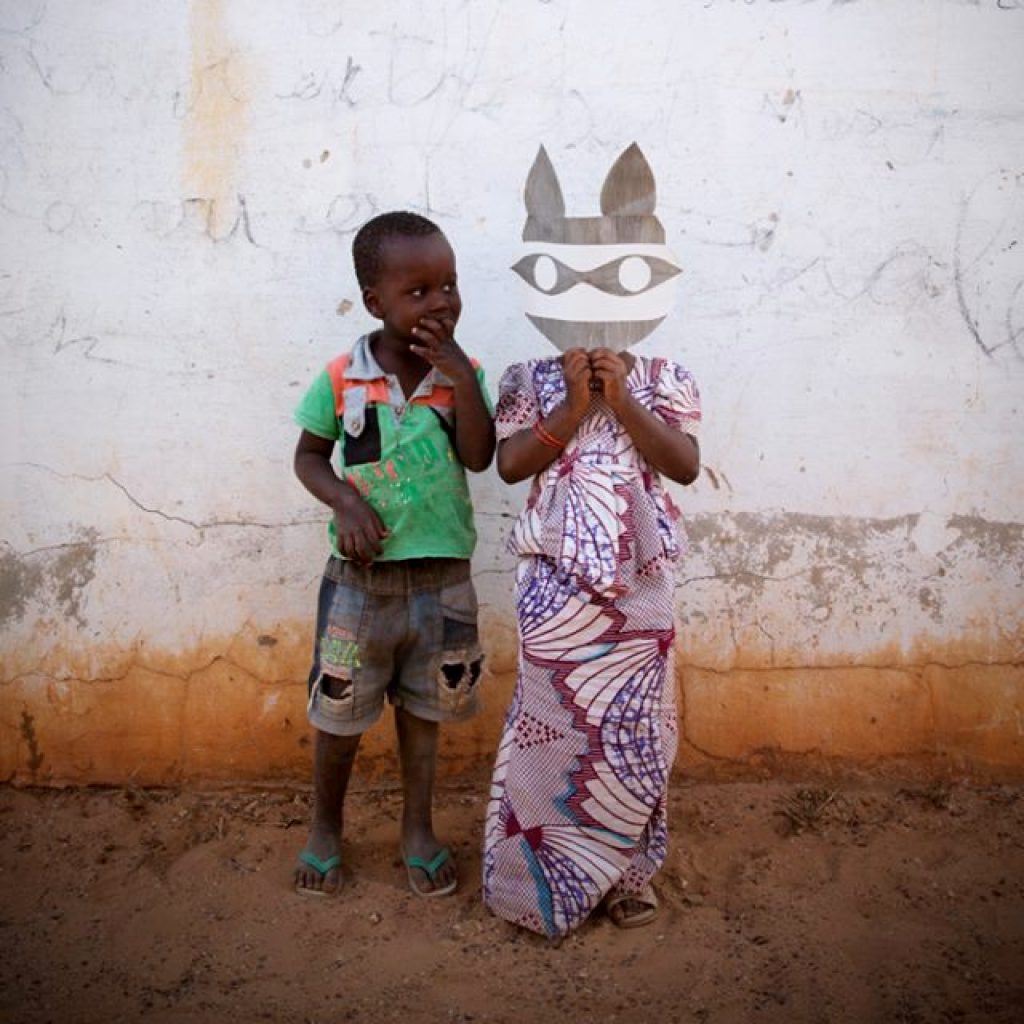Margot Hartford Senegal Mask series evolved during her recent GAP (Global Art Project) art residency in Dakar Senegal. Margot’s work is currently on display at Gallerie Renee Marie thru June.
I became aware of the The Senegal Mask Series and the work of Margot Hartford through artist and curator Carl Heyward whose GLOBAL ART PROJECT offered the opportunity for Margot and other international artists to collaborate and experiment in Africa this past winter during the GAP VII SENEGAL Residency outside of Dakar. He suggested that a solo exhibition of Margot’s work in the gallery might attract a diverse audience bringing those interested in the culture and peoples of Africa as well as a cross section of art enthusiasts to the space, which proved to be true. The juxtaposition of the personal and playful masks worn by the children of the arts compound creates a poignancy and immediacy and that is reflected in the remarks and written comments of collectors and visitors to the gallery. Renee Marie Jordan, gallerist
HAF: Tell us Margot, what was your inspiration to pursue this photographic project in Senegal during GAP VII?
Margot: The Senegal Mask photography series is the first purely photographic work I have done in over 10 years. Although many of my light boxes include my original photos I haven’t recently produced and photographed a series of images that included people and where the photograph is the final product. Seizing the opportunity to live and work in Senegal for 3 weeks, by participating in a GAP* (Global Art Project) residency, gave me the freedom to formulate a new photo series. The Senegal Mask series was inspired by black & white images I remember studying in school, taken in the 40’s and 50’s by photographers such as Irving Penn. I was originally planning to make the masks in my native California and to hire some models to pose with them. It was an obvious choice for me to change my direction and to initiate the series in Africa. Masks are everywhere in West Africa, they are on display in museums throughout Senegal and for sale in various shops.
HAF: What process did you employ in creating the masks?
Margot: The masks I made, by gluing together pieces of paper and then painting them with dark grey paint, are fashioned after various animals. I selected distinctive and recognizable features for each animal, and by exaggerating the size of their eyes and ears I was hoping to make the masks sweet and funny. My aim was to avoid the secrecy and eeriness that can be associated with masks, but to be light and joyful. I originally wanted the masks to be worn by adults, but 4 little girls were visiting the studio one afternoon and I arranged with their father to photograph them with the masks. I found a simple, long wall in the village, a few streets away from our studio, where I could photograph the 4 girls. We were only there for a few minutes before we had a swarm of local kids, all interested in eager to wear the paper contraptions and to pose for photos.
HAF: Were there any challenges you encountered during this residency?
Margot: The GAP residency had a few early challenges, with regards to the living conditions and studio supplies, but once we settled in we were all ready to work. There were 10 to 12 artists all working on different projects at different times of the day. The main emphasis was on paint and paper collage work, but one of the participating artist did a major paper boat installation. There was a wee bit of a language barrier, although I brought along a friend who spoke French so I could direct the older children when needed. Most of the really young children spoke only Wolof, their native language, so these children were really operating on “blind trust”, in more ways than one. There are no eyeholes punched out of the mask so the children wearing them were unable to see and had to be guided to the wall. I went out on the streets of the small village outside of Dakar where we were staying for the residency on three different occasions. I took hundreds of images and culled them down to 40 distinctive and engaging final photos.
HAF: Africa, specifically West Africa has a rich history of masks in the culture. Did this history have any bearing on your project?
Margot: Traditional African masks are used mainly for spiritual and religious practices. In ceremonies such as weddings and funerals the mask wearers’ identity is concealed, allowing the actor to become the spirit displayed on the mask. The wearer assumes the traits of the creature through gesture and dance, similar to someone on stage.




















